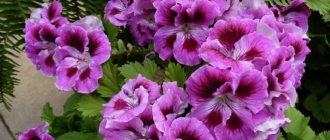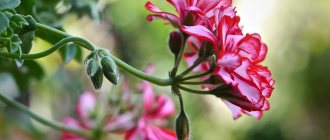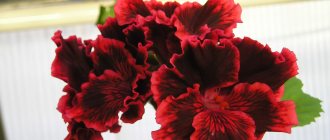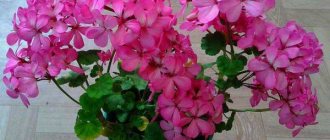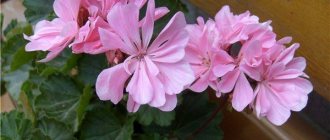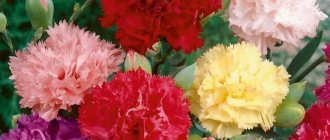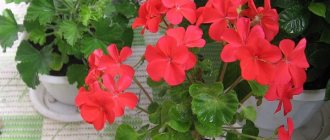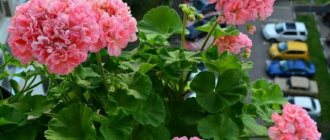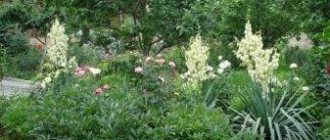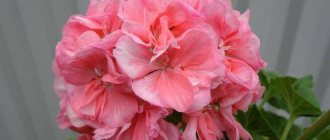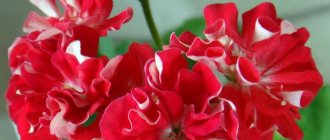Gorgeous flower - royal pelargonium: description, varieties with photos, care
Royal pelargonium got its name for a reason. Her appearance is truly royal. The buds are quite large - they can reach 15 centimeters in diameter. In addition, the inflorescences do not rise above the entire bush, but grow at the level of all shoots, which makes the bush very luxurious and large compared to other representatives of the pelargonium family.
In the article we will talk about the varieties of royal pelargonium, which, by the way, have now been bred in great numbers.
Royal geranium - what kind of flower is it?
Pelargonium royale was discovered in South Africa, and then transported to England and further spread throughout Europe.
The modern appearance of royal pelargonium, known to flower growers, it acquired thanks to the efforts of breeders, in particular, the botanist Liberty Hyde Bale. The scientist described the flower in 1901 and later worked on improving it.
The flower is distinguished by bright large inflorescences, an erect stem that can reach a height of up to one and a half meters (under favorable conditions and the absence of formative pruning).
Volumetric inflorescences up to 15 cm in diameter can form a continuous cap. This variety of pelargonium is distinguished by its long flowering period - with proper care it can last from mid-March to the end of October .
Geranium and pelargonium
Although both plants belong to the same family, and therefore have undoubted similarities, they have a number of significant differences, on the basis of which they are classified into different genera.
Similarities:
- They have a similar structure to the fruit capsule.
- The stems of the plants are erect, covered with small villi and alternately growing leaf blades.
- The specific aroma, characteristic of all members of the family, has similar notes in geranium and pelargonium.
- These plants are light-loving, easy to reproduce, and prefer warm climates.
But there are also features on the basis of which these types are divided:
- Geranium and pelargonium do not interbreed.
- Geranium has smaller single flowers, while pelargonium has large inflorescences formed by several large corollas.
- Pelargonium is more thermophilic and in winter needs a warm room with a temperature of at least 10...12 ° C, while geranium can easily endure the winter in open ground.
Features of the view
Many inexperienced gardeners confuse pelargonium with geranium. However, if you look closely, you can find quite a lot of differences. The most important difference is the shape of the flower. In geranium it is correct. But pelargonium does not, the bud is somewhat similar to the beak of a stork (which is where the name of the plant itself comes from).
Royal pelargonium was first described at the beginning of the twentieth century - in 1901. This species was the result of long-term crossing work. This was done by botanist Liberty Hyde Bailey. The scientist also found out that most of these flowers grow in England, the Netherlands and Germany. This plant is considered aristocratic not only because of its name, but also because of its whimsical care. Not all flower growers have the patience to care for the “Queen”.
The following factors can be attributed to the peculiarities of cultivation::
- short flowering period;
- any, even the most insignificant, mistake during cultivation can lead to the absence of buds;
- outdoors, the plant may die; it is better not to expose it to the street;
- It is very difficult to propagate the royal flower.
The leaf plates have a rough surface and pointed edges. The buds can be either simple or double. Another feature of the petals is the presence of a spot in the center on each of them . It is also worth mentioning that the shoots begin to become stiff at the base.
Common types
Royal pelargonium has a rather complex classification .
Conventionally, all its varieties and varieties can be divided into several groups. Further details about each of them. Candy Flowers is a series of large-flowered varieties that are the result of crossing a representative of the main group of royal pelargoniums with a representative of the Angels subgroup. The plants presented in the Candy Flowers group are distinguished by abundant and lush flowering and unpretentiousness. Ideal for growing in open ground. These include:
- Cambi . A variety with delicate two-color inflorescences with light pink veins and a spot on the petals.
- Camred . It is distinguished by luxurious flowering of cherry blossoms with a faint black spot on the petals.
- Camdared . It features beautiful dark red flowers with a lighter back side of the petals.
The Angels group of royal pelargoniums is represented by low-growing varieties with cute flowers that look very much like pansies. They do not require the traditional wintering for royal pelargoniums. They don't bloom for very long, but they bloom luxuriantly. Some of the species have very fragrant foliage. These include:
- Spanish Angel . Compact bushes reaching a height of 30-35 cm. Flowers are medium-sized (usually reaching a diameter of about 3-3.5 cm), two-colored (upper petals are dark red, lower petals are purple).
- Imperial Butterfly . The plant reaches a height of 30 cm. The flowers have an original color: white with pointed fuchsia edges, exuding a faint lemon aroma.
- Darmsden . The height of the plant is similar to the previous type. The leaves have a rounded shape. The flowers are two-colored: the upper petals are cherry with a pinkish tint, and the lower petals are white.
- PAC Angeleyes Viola . A profusely blooming species with beautiful pink flowers (each petal has a crimson spot). The leaves have a subtle citrus aroma.
Photos of different varieties
Below are photos of varieties of royal pelargonium with names, in particular tangerine, white, astero pink.
Names of popular varieties with descriptions and photos
There are quite a few varieties of royal pelargonium. We will describe only the most popular ones.
Mandarin
The bush of this species is very compact, but to achieve the correct shape, you need to work hard and regularly trim the growing shoots. The advantage is long flowering, which begins quite early - at the very beginning of spring. The foliage is monochromatic - dark green. To enjoy lush flowering in the spring, the plant should be kept in a cool room during December and January. The buds are similar in shape to petunia buds , only the former are larger in size.
White
This variety is not particularly different from the previous one. Only in colors. The inflorescences of this variety are white, and in the very center you can see lilac or dark pink inclusions (sometimes stains). The leaf blades are the same shade, but it is a little lighter than that of Mandarin. Flowering lasts up to six months - starting in March and ending in September.
Astero pink
This variety is loved and appreciated for its extraordinary appearance. The colors of its flowers will surprise even the most whimsical gardeners. The shade of the petals was obtained by mixing pink and brick colors . Also in the middle there are inclusions of darker colors, which gives the whole plant a certain charm. This species does not bloom for so long compared to its “brothers” - about 4-5 months. But it is very lush and plentiful - the buds bloom one by one.
Varieties of indoor plants with names and what they look like
Depending on the variety, you can get pelargonium of various colors. Each variety evokes special admiration among gardeners, and therefore, despite the difficult nature of the flowers, many lovers want to purchase a royal specimen for their home.
"Mandarin"
The fiery red or orange flowers of the royal pelargonium variety Mandarin often exceed 6 cm in diameter. In the middle, the color fades noticeably to a creamy white color. Thin purple stripes run from the core to the edges of the petals. The flower is semi-double with wavy edges.
"Mona Lisa"
Early flowering variety. Large white flowers have crimson spots in the core. The edges of the petals are wavy. It blooms for a long time, compared to other varieties. The inflorescences reach a diameter of 5 cm.
"Morvena"
The plant is quite compact with large burgundy-black inflorescences that look beautiful against the background of bright green foliage. The plant blooms for a long time, grows well, while maintaining its decorative properties.
"Elegance Jeanette"
Another early variety of the royal species of pelargonium-grandiflora. Elegance Janet has large flowers, they are lilac-pink with darker spots. The variety is quite compact, green leaves, blooms in the cold season for 1.5 months.
"Clerion Bright Red"
The variety belongs to the variety of royal pelargonium multiflora. The flowers are medium-sized, curly, cherry-red with a black spot at the base of the petals.
The variety blooms profusely and for a long time, and does not require cool maintenance in winter, since it blooms in the summer.
Clerion bright ed
Rules of care
The recommendations described below must be followed in order to achieve full growth and development and abundant flowering for a long time.
- Watering mode . “Queen” will not tolerate excessive soil moisture - the plant may die immediately. Therefore, new watering can be carried out only if the soil has completely dried out after the previous one. To moisten the substrate, choose only settled water at room temperature. It is best to water the plant through a tray. This way the flower will take the required amount of water, and the grower will be able to remove the excess. This can be done a quarter of an hour after watering.
- Feeding . Royal pelargonium needs to be fertilized only during the growing season - from March to October. Next, the plant goes to rest. In winter, you should avoid fertilizers altogether. Otherwise, the flower will not understand that a period of rest has begun and will not be able to fully recover over the winter.
Preference should be given only to complex fertilizers in liquid form. It is necessary that they contain potassium, phosphorus and nitrogen in equal quantities. Transplant . It is necessary to change the “place of residence” for royal pelargonium, but not every year. Once every two to three years will be enough. To understand that the plant has become crowded, you need to look at the drainage holes in the flowerpot. If roots have already appeared in them, then it’s time to choose a larger container. But you shouldn’t change the pot to a very large one. You only need to increase its diameter by 4-5 centimeters. Otherwise, all the growth will go to the root system, and not to the above-ground part.
During transplantation, the substrate can also be renewed, since it loses its nutritional properties over time. The soil can be purchased at the store, or you can prepare it yourself. To do this, soil is taken from the garden, peat and river sand. All these components must be taken in equal proportions.
This can only be done with a well-sharpened and disinfected instrument. After the procedure, the cut sites are treated with fungicides or simple wood ash to prevent the possibility of rotting.
Air temperature and humidity . Royal pelargonium does not like too humid air, so experienced gardeners recommend keeping this indicator slightly above average. The exception is days of extreme heat. At this time, you can lightly spray the air around the plant, but do not spray water directly onto the surface of the flower, as this can cause burns.
As for the temperature, it should be above average. In summer, the most suitable temperatures are 22-25 degrees during the day, at night the air should be less warmed up - to about 18-20 degrees above zero.
It is necessary to ensure that the substrate does not overheat in the sun. Since such a process can lead to the development of diseases of the root system. Wintering . Royal pelargonium needs a period of rest in order to gain strength for the new growing season. Plants always rest in winter. At this time, the temperature drops to about 15 degrees Celsius. Moistening the soil should occur no more than once a week. You also need to move the flower pot to a darker room.
If the gardener refuses the wintering period, then next spring he may not expect a new flowering (read about why royal pelargonium does not bloom and how to correct the situation here). Or the buds will be so small that they can hardly be called royal.
More information about caring for Royal Pelargonium is described in this video:
In the article we talked about the varieties of Royal Pelargonium and the rules for its cultivation. Some may think that this plant is too whimsical in its care. But those who have at least once seen the “queen” live and appreciated its magnificent inflorescences, contrasting with the monochromatic foliage, stop thinking about the difficulties of growing and immediately replenish their flower collections with this beauty.
If you find an error, please select a piece of text and press Ctrl+Enter.
Geranium (pelargonium)
. Seasonal plant. On sale from April to August.
Geranium (pelargonium) mix – Pelargonium D9 H15
Geranium (pelargonium) – Pelargonium D9 H15
Geranium (pelargonium) – Pelargonium D9 H15
Geranium (pelargonium) – Pelargonium D9 H15
Geranium (pelargonium) – Pelargonium D9 H15
Geranium (pelargonium) – Pelargonium D9 H15
Geranium (pelargonium) – Pelargonium D9 H15
Geranium (pelargonium) – Pelargonium D9 H15
Geranium (pelargonium) – Pelargonium D11 H20
Geranium (pelargonium) – Pelargonium D11 H20
Geranium (pelargonium) – Pelargonium D11 H20
Geranium (pelargonium) – Pelargonium D11 H20
Geranium (pelargonium) – lat. Pelargonium: home care
Perennial herbaceous or semi-shrub plants. Grows in South Africa. Used to obtain essential oil .
Geranium (Pelargonium) is one of the most popular indoor plants of our time. For 300 years, these flowers have been decorating the windows and gardens of residential buildings. Geranium has an attractive appearance and a lot of positive qualities. This is a unique plant that can be grown both in apartments and in flower beds. The name of the flower is translated from Greek as “crane”. Its homeland is South Africa. It belongs to the Geraniev family.
Pelargonium is the only plant that can protect surrounding flowers from pests. Essential oils released from the leaves create a protective barrier against viruses and dangerous bacteria. Previously, the flowers of the plant were used to relieve headaches and muscle discomfort. The juice and tinctures of this plant are still used to heal wounds and treat conjunctivitis.
Caring for Pelargonium (Geranium) is very simple. It grows well under any conditions and pleases with its flowering for a long time.
Appearance of the Geranium plant
This type of flower is presented in the form of a subshrub. With proper care it grows up to 60 centimeters tall. Most types of Geranium have a well-branched root system. At the ends of the roots there are small thickenings that retain moisture and nourish the plant with it during the dry period.
Depending on the variety, the foliage takes on different shapes. The plate is slightly dissected and attached to a short petiole. In many varieties of Pelargonium, the surface of the leaves is covered with small fibers. Their color can be green, grayish, red and even with light splashes.
Geranium has large buds. They are colored in purple, white, pink and red. The flowers can be either single or collected in small inflorescences. You can see the first buds in early May. The end of flowering occurs in the month of August. In place of the flowers, seed boxes are formed.
There are many species of Geranium in nature. They all differ in the shape and shade of the buds. Often, zonal Pelargonium or Kalachik are grown at home. In order to achieve long-term flowering, it is enough to follow some rules.
Popular varieties of Geranium:
1. “ Ivy ” or “ Thyroid ”. This is an ampelous species that is planted in hanging flowerpots. The shoots are long, but very brittle. With proper care, they grow up to a meter in length. The inflorescences have a racemose shape. Flowers can be double or semi-double.
2. “ Royal ”. Differs in different shapes and shades of flowers. The leaves are variegated. The bush grows up to half a meter high. The petals are terry, on the surface of which there is a dark spot or stripes.
3. " Fragrant ". One of the most unusual and at the same time popular species. Its uniqueness lies in the smell it gives off. Often, Fragrant Geranium has an aroma reminiscent of lemon, almond, pepper, lemon balm, mint, ginger, and pineapple. This type is used in cosmetology. The buds are small. They can be pink or purple.
4. “ Angels ”. Flowers of this type are similar to Pansies. The buds are collected in spherical inflorescences. Pelargonium bushes grow up to 30 centimeters tall.
5. " Unique ". The leaf blades are very dissected. It has a spicy, rich aroma. The inflorescences are fluffy and large.
All types of Geraniums that are available in the Mandarin store are presented in the photo. Such plants are perfect for growing in apartments, offices, medical institutions, kindergartens and schools. Experienced gardeners often use bushes to create unusual compositions in winter gardens and greenhouses.
Basic rules for caring for Geranium at home
Lighting . In order for Pelargonium to bloom profusely, it is necessary to provide it with good lighting. The plant is not afraid of direct sunlight. It is necessary to shade the bush only during the hottest period of the day. If there is not enough light, the leaves will become small and begin to break.
Air temperature . Geranium is a cold-resistant flower. It feels good at any temperature, the main thing is that the thermometer readings do not fall below +100C. If this is not taken into account, the bush will cease to please with its flowering. The optimal temperature in summer is +22C. In winter – +15C.
Irrigation . In cold months, the flower should be watered no more than twice a week, provided there is good lighting. During the warm season, the procedure must be carried out every day. During irrigation, it is important to ensure that water does not get on the leaves, otherwise light spots will appear on the surface of the plates. The liquid should only be used at room temperature. Water must be filtered or well settled.
Substrate . Pelargonium must be planted only in special soil. You can buy soil for the bush or prepare it yourself. A high-quality substrate should consist of garden soil, sand and peat. All components must be used in equal parts.
Fertilizer . It is recommended to use only mineral products as a top dressing. The preparations should consist of large amounts of phosphorus and potassium. At the end of flowering, nitrogen fertilizers should be applied. The procedure must be carried out once a week.
Reproduction . You can grow a new plant from seeds and cuttings. The last method is the simplest and most effective. Before planting, the cuttings must be placed in a glass of water until roots appear, and then planted in the ground.
Where to buy Geranium in St. Petersburg?
Any type of Pelargonium can be purchased in our flower shop. Buying a flower is very simple. You can place orders in two ways: by phone and by filling out an online form. To customers in St. Petersburg and the region, the plant will be delivered by courier the next day. Any questions you may have can be asked to our experienced specialists. "Mandarin" will make your life happy!
Features of plant flowering
Decembrist flower: home care conditions and reasons for not blooming
Depending on the variety of geranium or pelargonium, flowering occurs at different times of the year. But if for ordinary geranium this period lasts about 5-6 months, then royal pelargonium is stingy, so you can admire its flowers for 3-4 months.
With proper maintenance, you can achieve year-round flowering of pelargonium, but in this case the inflorescences will be smaller than they could be. In order for them to become normal, it is necessary to give the flower a rest. After a period of dormancy, the abundance of flowering will increase.
Types and shape of flowers
Breeders have developed a large number of hybrids and varieties, the shape, color and leaves of which have distinctive characteristics. The indoor view is divided into several groups.
- Ivy-leaved
Ivy-leaved pelargonium is an ampelous species of herbaceous plants. Fragile drooping shoots can reach a length of 1 m.
The group got its name for a reason - its leaves resemble ivy. Double and semi-double flowers can reach 5 cm in size. The color varies from pure white to blue-black.
Geranium ivy-leaved
- Angel
Externally, the inflorescences of this type of pelargonium resemble “pansies”. The height of the plant can reach 35 cm.
Geranium Angel is easy to care for and blooms throughout the summer. Flowers can be white, pinkish, purple, lilac.
- Unique
This type of plant is one of the oldest. It was developed by crossing royal and brilliant varieties. Has a light spicy smell.
The flowers are smaller in size than those of the royal geranium and are white or red in color.
Pelargonium mandarin
Pelargonium royal Mandarin (Pelargonium grandiflorum Manderin) – a variety of early long flowering; The flowers are large, semi-double orange flowers with a thin white wavy pencil border. The upper petals have red-brown spots, turning into an openwork mesh. The base of the flower has a wide white throat; the lower petals have dark brown streaks on the white.
Description Royal Pelargonium Mandarin (Pelargonium grandiflorum Manderin). Compact variety , characterized by early and long flowering. The leaves are a uniform green color. For abundant flowering, it requires cold maintenance for 4-6 weeks (December-January).
, royal pelargonium deserves special attention . A true aristocrat, it is distinguished by beautiful large foliage of various shapes depending on the variety, lush inflorescences consisting of large (up to 5 cm) flowers. In shape they resemble petunia flowers , simple or double. The petals can be painted in a wide variety of colors: from white to dark red, through all the variety of pinks, reds and purples; they can be plain or with spots, streaks, corrugated, fringed or torn. Flowering is very abundant and colorful, lasting from May-June to August-September. The shoots of royal pelargonium become woody at the base. Like other varieties, the leaves of Pelargonium royale are pubescent and have a characteristic aroma, but many varieties have odorless leaves.
Location Pelargonium royal Mandarin (Pelargonium grandiflorum Manderin). The optimal location for royal pelargonium is an eastern window with diffused sunlight, but without a heating radiator under the window sill. This species is not suitable for planting in the garden in the summer, as it is afraid of rain and wind, but feels good on closed verandas, terraces and loggias. When the first frost occurs, the plant must be moved to a warm place.
Temperature regime for Pelargonium royal Mandarin (Pelargonium grandiflorum Manderin). Royal pelargonium does not tolerate extreme heat: at temperatures significantly above +25 ° C, it stops growing and does not bloom. In winter, the optimal temperature is within +15. +20 °C.
Planting Royal Pelargonium Royal Mandarin (Pelargonium grandiflorum Manderin). The best container for planting royal pelargonium will be a ceramic pot with perforations to drain excess moisture. Be sure to provide drainage, and use a mixture of turf soil with a high organic content as a substrate. Within two weeks after planting, provide the plants with shade and timely watering.
Care of Royal Pelargonium Mandarin (Pelargonium grandiflorum Manderin). The main conditions for successfully growing royal pelargonium are maintaining the correct temperature, additional lighting and moderate watering. Regular pinching of the tops of the shoots ensures better tillering of the bush, but it must be stopped long before flowering to allow buds to form. Young plants bloom more abundantly than adults, so annual propagation of pelargonium is recommended. During the period of active growth, feed plants with low doses of fertilizers with a high content of potassium and microelements. During the period from March to August, provide the plants with regular watering, but do not allow stagnation of moisture. Remove fading inflorescences promptly.
Reproduction of Royal Pelargonium Mandarin (Pelargonium grandiflorum Manderin). To propagate royal pelargonium, cuttings from apical shoots are used. The best time for reproduction is late summer-early autumn. Before planting in the substrate, sprinkle the cuttings with crushed coal with the addition of “root” and dry for a couple of hours. Rooting in water is not suitable for cuttings of royal pelargonium: with this method they will inevitably rot. After rooting, the cuttings are transplanted into pots with a light nutrient substrate and drainage at the bottom.
Use of Royal Pelargonium Mandarin (Pelargonium grandiflorum Manderin). Royal pelargonium is more of a houseplant ; it is successfully grown in greenhouses and winter gardens, and during the warm season it decorates closed terraces, verandas and loggias.
The online store of garden plants "Garshinka" has the largest collection of plants and carefully delivers planting material from all over the world throughout Russia. We guarantee the quality and grade of the supplied material. We store plants ready for shipment in special conditions. We pack parcels in a secure manner. We notify you about shipment and control the parcel en route. We work on a 100% prepayment basis in order to reserve the best varieties for you and guarantee on-time delivery without postage or commissions.
We recommend purchasing garden plants from the Garshinka online store to experienced and novice gardeners, landscape designers and joint purchasing communities. There is a unique offer for every buyer. Here you can buy various planting materials: seedlings of roses, fruit and ornamental trees and shrubs, all groups of conifers, standard species, rhizomes of perennial flowers, bulbous plants for autumn and spring planting, lawn grass seeds, fertilizers and pest control products.
GOODS TO DISTANT REGIONS ARE DELIVERED ONLY BY EMS DELIVERY. FAR REGIONS INCLUDE: Republic of Tyva, Republic of Buryatia, Republic of Sakha (Yakutia), Primorsky Territory, Khabarovsk Territory, Amur Region, Altai Territory, Kamchatka Territory, Sakhalin Region, Transbaikal Territory, Jewish Autonomous Region, Chukotka Autonomous Okrug. Irkutsk region, Magadan region, Yamalo-Nenets Autonomous Okrug, Altai Republic, Krasnoyarsk Territory
Flower propagation by cuttings
The fastest way to propagate geraniums is by cuttings. It is available at any time of the year. A supply of cuttings should be made during spring pruning; they take root better than others. Branches should be cut at least 5 cm in length, which have about 3 leaves and 3 internodes. If there are inflorescences, they should be cut off.
The cut should be treated with activated carbon and left to dry at room temperature for some time. It is recommended to plant cuttings in separate small pots. You can use plastic cups with drainage holes cut into them. It is worth placing drainage at the bottom and adding sand to the soil.
It is advisable to disinfect the soil by pouring boiling water or a manganese solution over it. It is necessary to give the substrate a day to cool down. Before planting, it is worth treating the planting material with a root formation accelerator.
The cuttings should be deepened into the substrate by a couple of centimeters, and the containers with plantings should be taken out into a dimly lit room for 5 days. After this time, you can put it on the windowsill and continue to care for it as you would an ordinary plant.
Additional Information! If the cuttings fail and begin to turn yellow, it is recommended to place them in a greenhouse, covered with glass or plastic film.
Royal geranium cuttings
